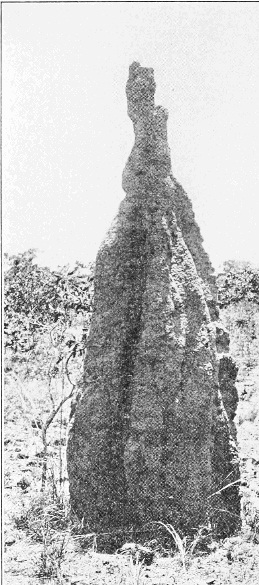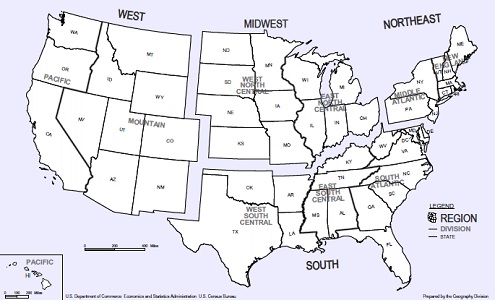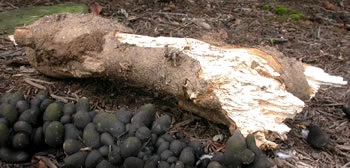Where Is Xylaria polymorpha Found and How Does It Interact with Other Critters?
X. polymorpha lives mostly where there is decaying wood. Fruiting bodies will grow out of stumps or logs in clusters or alone. Sometimes X. polymorpha appears to rest upon the ground itself, but underneath its fruiting bodies lies a piece of buried wood10. In the United States, X. polymorpha is common in northeastern, southeastern, and northern midwestern states. On the contrary, most of the Rocky Mountain states have no record of X. polymorpha, and X. polymorpha is considered rare in other western states. Even in southern midwestern states X. polymorpha appears less frequently, but the considerably smaller amount of decaying wood may contribute to X. polymorpha's uncommonness in these states14. Xylaria exist in many other countries as well. Scientist have isolated X. angulosa from termite nests in Japan and from soil in Indonesia11. Other Xylaria have been found also in termite nests in South Africa20. X. polymorpha and other Xylaria species commonly inhabit forests in England4. To add to the list, scientists have isolated endophytic Xylaria from Europe, Panama, Malaysia, Japan, China, the Brazilian Amazon, Puerto Rico, and China3. Along with such a broad distribution in countries, Xylaria inhabit many different niches as well.
X. polymorpha grows on the decaying wood of too many species of trees to count, especially sense decaying wood is difficult to identify. Most species that serve as hosts to X. polymorpha are angiosperms and includes genera such as Citrus, Ulmus, Quercus, and Malus14. To make things more complicated, many Xylaria act as endophytic fungi in a very diverse range of plants, from many vascular genera (e.g. Acer) to liverworts. These endophytic Xylaria can be found in various parts of the plant, often depending on the particular species. Some are found in mainly vascular tissue. Others seem to be mostly in bark. Still others reside in the veins of leafs or in the rhizoids of liverworts. A person may ask how the endophytic Xylaria spread to other plants? This is not completely understood, but evidence suggests through the seeds of the plants or, like non-endophytic Xylaria, conidia and ascospore dispersal 3.
 Sense there are many
species of Xylaria, multiple hypotheses exists for the role
each species plays in endophytic relationships. One hypothesis is
that endophytic Xylaria tactically wait for the plant to
start decaying so they can be the first fungus to the smorgasbord
3. Another hypothesis is that some Xylaria switch
from endophorytes in some plant species to saprophytes (decomposers
of dead or decaying organic material) of different plant species
3,10. Fungi that live these Jekyll and Hyde lifestyles
are known as "foragers." Some scientist think that some Xylaria
have specialized as only endophytic fungi. However, characteristics
of endophytic Xylaria associate most closely with the
characteristics of other endophytic mutualistic fungi3.
Sense there are many
species of Xylaria, multiple hypotheses exists for the role
each species plays in endophytic relationships. One hypothesis is
that endophytic Xylaria tactically wait for the plant to
start decaying so they can be the first fungus to the smorgasbord
3. Another hypothesis is that some Xylaria switch
from endophorytes in some plant species to saprophytes (decomposers
of dead or decaying organic material) of different plant species
3,10. Fungi that live these Jekyll and Hyde lifestyles
are known as "foragers." Some scientist think that some Xylaria
have specialized as only endophytic fungi. However, characteristics
of endophytic Xylaria associate most closely with the
characteristics of other endophytic mutualistic fungi3.
Here is a description of
how an endophytic fungus generally relates with a plant. The fungus
lives within the living plant tissue, but causes no apparent harm to
the plant. The plant provides food and protection for the fungus. In
return the fungus produces bioactive metabolites, protecting the
plant from hungry herbivores and nasty plant pathogens. A symbiotic
relationship that can even benefit humans, because the bioactive
metabolites of the endophytic fungus can be used to make
insecticides or antibiotics or other useful chemicals21.
Another
interesting place that Xylaria inhabit is termite nests. In
fact, Xylaria species that associate with termite nests
almost only live in termite nests with fungus-growing termites (termites
that are in an obligate symbiosis with the Termitomyces fungi).
Much is still uncertain about the exact relationship between the
termites and the Xylaria. Some scientists hypothesize the
termites carry spores on their body or in their guts into the nest.
The Xylaria then hide out in small crannies of the nest.
Once the termite colony leaves or dies off, the Xylaria
take over the nest, feeding on the tasty partially digested wood
left by the termites20.
The next page describes how X. polymorpha actually gets its food. Click the link to find out!


